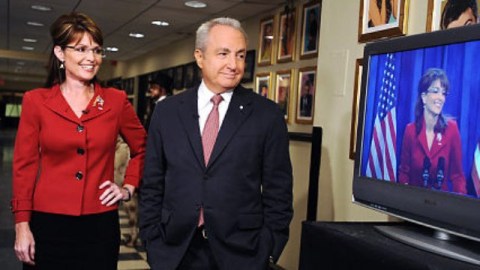The Rally to Restore Sanity: A Growing Impact for Political Parody?

Last week, The Daily Show’s Jon Stewart announced the “Rally to Restore Sanity,” to be held October 30 on the National Mall. “Ours is a rally for the people who’ve been too busy to go to rallies,” said Stewart. “Who actually have lives and families and jobs (or are looking for jobs) — not so much the Silent Majority as the Busy Majority.” More than 1,000 news stories have run about the event and close to a million people have watched the clip online [see embed bottom of post].
Not since the 2008 election, when Tina Fey’s parodies of Sarah Palin became must-see Saturday Night Live viewing, has political entertainment driven this much discussion. Yet if the SNL parodies marked a major milepost in the ascent of televised satire, Stewart’s announcement potentially represents the next great evolution, with the possibility of the event translating into large-scale political mobilization.
In Q&A posts last week, Lauren Feldman, my colleague here in the School of Communication at American University, discussed why political candidates choose to appear on late night comedy programs such as The Daily Show, as well as the program’s impact on news coverage and audience learning about politics.
In this last part of her interview, I asked her to address what is known about the impact of parody–such as those of Sarah Palin–on viewer perceptions and campaigns. She also discusses why conservatives sometimes don’t realize that they are often being made fun of by Stephen Colbert–Matthew C. Nisbet
Apart from having political figures as guests on the show, when these programs use skits to parody a political figure, do these portrayals influence public perceptions?
One way that comedic sketches and parodies might influence public perceptions is through a cognitive phenomenon called political priming. By accentuating certain negative character traits or image characteristics of politicians, late-night comics make these attributes more top of mind for viewers – that is, they “prime,” or activate, them in viewers’ memories. As a result, people are more likely to think about these traits when forming judgments about the politicians in question.
We also know that political comedy suppresses argument scrutiny. What this means is that when audiences are exposed to political humor or satire they are less likely to counter-argue the information contained in the message or question the fairness or accuracy of the message, relative to a non-humorous message. Thus, with parodies and other comedic portrayals that paint politicians in a negative light, there is greater opportunity – relative to more traditional political attacks in campaign advertisements, for example – for this negative information to be absorbed by audiences and ultimately affect their perceptions.
Specifically, what do you think the impact was of the Sarah Palin skits on Saturday Night Live?
Tina Fey’s impersonations of Palin likely had a priming effect, as just described. For example, by accentuating Palin’s folksiness, the incoherence and lack of specificity of her responses in media interviews and in the Vice Presidential debate, even her style of speech (e.g., her accent, dropping the “g” at the end of words, etc.), Fey’s impersonations may have made these negative attributes weigh more heavily in voters’ evaluations of Palin, contributing indirectly to a more unfavorable rating of the McCain/Palin ticket. This political priming effect was likely exacerbated by the fact that the SNL sketches were widely rebroadcast on mainstream news programs, YouTube, and on blogs and social media sites, thereby increasing voters’ exposure to the parodies of Palin.
Tina Fey’s impersonation of Sarah Palin was also unique among parodies of political figures, in that it easily came to serve as a proxy or stand-in for the real Sarah Palin. That is, because the news media were restricted in their access to Palin during the 2008 campaign, many voters may have seen more of Fey parodying Palin than of Palin herself, leading them to accept the SNL parodies as “reality.” In fact, data collected by the Pew Research Center during the 2008 campaign revealed that the public was just as familiar with Fey’s parodies of Palin on SNL as they were with the interview the real Palin did with Katie Couric on CBS. This may explain why many voters mistakenly attributed Tina Fey’s quote “I can see Russia from my house” to the real Palin, whereas what Palin actually said was, “They’re our next-door neighbors and you can actually see Russia from land here in Alaska, from an island in Alaska.” Danna Young at the University of Delaware is currently researching the extent to which the mainstream news media covered Fey’s parodies of Palin and how this may have contributed to the conflation of the two.
Do all viewers respond to these types of parodies in the same way?
These types of parodies will likely have a more pronounced effect among viewers who don’t have strong opinions or background knowledge about the political figure being parodied. Without prior knowledge or views to fall back on, people will be more likely to accept the image of the politician portrayed in the parodies and to rely on that image when forming an overall impression of the politician. Viewers will also respond differently based on their political orientation or ideology. For example, in the case of the SNL parodies of Sarah Palin, liberal or Democratic viewers were likely reinforced in their negative opinions of Palin, whereas conservative or Republican viewers would have been more likely to reject the parodies as unfair or exaggerated. What is notable about SNL is that by being an entertainment program without a readily identifiable political leaning, it draws viewers from the left and the right, as well as political moderates. It is this latter group, comprised of people who may not have strong prior opinions, who are likely to be most influenced by the show’s political sketches.
Do you think that some viewers do not get that Colbert is actually making fun of many guests as well as their own political beliefs? What accounts for these ironic blind spot among some viewers?
Yes, and, in fact, there is an interesting study that shows just this. Heather LaMarre and colleagues found that viewers’ interpretations of Stephen Colbert’s comedy varied based on their ideological predispositions. For those who are unfamiliar with the show, Colbert parodies a conservative political pundit. He rarely breaks character and thus relies on irony and deadpan humor to critique conservative viewpoints. LaMarre et al. found that while liberals and conservatives thought Colbert was equally funny, conservatives tended to misinterpret Colbert’s sarcasm as sincerity – that is, they thought he was only pretending to be joking and that he was genuine in his political statements. Liberals, on the other hand, were better able to recognize Colbert’s use of satire and understand that he was being ironic, for example, when he assailed liberal positions. Essentially, what we are seeing here is a pattern of biased processing, or motivated reasoning. Research in political psychology tells us that partisans tend to interpret ambiguous information – which would include Colbert’s satire – in a way that confirms or supports their personal political views. Through his use of irony, Colbert opens himself up to multiple interpretations, and viewers see what they want to see, on the basis of their existing beliefs.
–Interview with Lauren Feldman, American University
See Also:
What Viewers Learn about Politics from The Daily Show
Researcher Examines Daily Show’s Impact on Political Culture
Watch Stewart’s announcement below:
The Daily Show With Jon Stewart Mon – Thurs 11p / 10c Rally to Restore Sanitywww.thedailyshow.com
Daily Show Full EpisodesPolitical HumorTea Party





